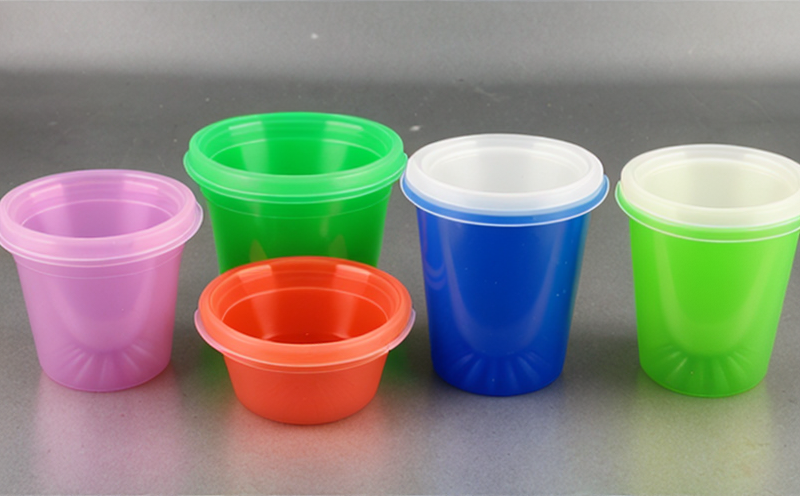ISO 489 Refractive Index Testing of Disposable Plastics
The ISO 489 standard provides a method for measuring the refractive index of transparent materials like plastic, which is critical in assessing the quality and performance of disposable plastics used across various industries. This testing ensures that products meet specific optical properties required for their intended applications.
Refractive index plays a crucial role in determining how light behaves as it passes through a material. For disposable plastics, this can affect transparency, clarity, and coloration, which are vital factors influencing the product's performance and customer satisfaction. In medical devices, for instance, accurate refractive index measurements ensure that the plastic components do not alter the optical properties of the device, affecting its functionality.
The testing process typically involves placing a sample in contact with an appropriate medium (often air or another transparent fluid) and measuring how light bends as it travels through. This is done using precision instruments such as Abbe refractometers or polarimeters. The results are then compared against specified standards to ensure compliance.
Accurate measurement of the refractive index helps in quality control by identifying variations that could indicate impurities, additives, or other factors affecting the material's properties. This is particularly important for disposable plastics used in single-use medical devices where any deviation from expected optical behavior can have significant implications on product performance and safety.
The standard specifies detailed procedures to ensure consistent and accurate testing, including specimen preparation, calibration of equipment, and handling methods to minimize external influences. Compliance with these protocols ensures reliable data that can be trusted for making informed decisions about the quality of disposable plastics.
Understanding the refractive index is also key in ensuring compatibility between different components within a single device or assembly. For instance, in a medical syringe, the plastic plunger must have a compatible optical property with the barrel to avoid light scattering and ensure clear visibility during use. This testing ensures that such interactions do not compromise the overall performance of the product.
In summary, ISO 489 refractive index testing is an essential tool for ensuring the quality and consistency of disposable plastics in various applications. It provides critical insights into material properties that directly impact product performance and safety, making it a cornerstone of modern quality assurance practices.
Benefits
The implementation of ISO 489 refractive index testing offers numerous benefits to manufacturers and users of disposable plastics:
- Informed Decision-Making: Accurate data helps in making informed choices regarding material selection and process optimization.
- Improved Product Quality: Ensures that the materials used meet stringent optical property requirements, leading to higher-quality products.
- Enhanced Customer Satisfaction: By ensuring consistent performance across batches, manufacturers can build trust with their customers.
- Compliance with Standards: Adherence to international standards like ISO 489 ensures that the product meets regulatory requirements and industry expectations.
- Cost Efficiency: Early identification of defective materials through testing reduces waste and rework costs.
- Innovation Support: Reliable data from this test can guide research and development efforts, leading to new innovations in material science.
The benefits extend beyond manufacturing; it also supports the sustainability goals by ensuring that disposable plastics are optimized for their intended use without unnecessary additives or impurities.
Why Choose This Test
Selecting ISO 489 refractive index testing is advantageous due to several factors:
- Precision and Reliability: The test provides precise measurements that are highly reliable, ensuring consistent results across multiple samples.
- Industry-Wide Recognition: Being a widely recognized standard, it ensures compatibility with global quality standards.
- Scientific Basis: Backed by scientific principles and rigorous testing procedures, the results can be trusted for decision-making processes.
- Cost-Effective: Despite initial setup costs, the long-term benefits in terms of product quality and customer satisfaction make it a cost-effective choice.
- Educational Value: The test offers educational value to professionals involved in polymer science and material engineering.
- Comprehensive Coverage: ISO 489 covers a wide range of transparent plastic materials, making it versatile for various applications.
The combination of these factors makes ISO 489 refractive index testing an indispensable part of any quality assurance program in the polymer and plastics industry.
Customer Impact and Satisfaction
The impact of ISO 489 refractive index testing extends to customers in several ways:
- Better Product Performance: Customers receive products that meet or exceed performance expectations, enhancing user experience.
- Increased Trust: Consistent quality and reliability build trust between manufacturers and customers.
- Enhanced Safety: Ensures that the materials used in disposable plastics do not pose any health risks to end users.
- Sustainable Practices: By optimizing material properties, it supports sustainable manufacturing practices.
- Competitive Advantage: High-quality products can differentiate a company from its competitors, boosting market share.
- Regulatory Compliance: Ensures that the product complies with all relevant regulations and standards.
The overall impact of this testing is to create satisfied customers who are reassured about the quality and safety of the products they use. This satisfaction translates into repeat business and positive brand reputation, crucial for long-term success in the industry.





